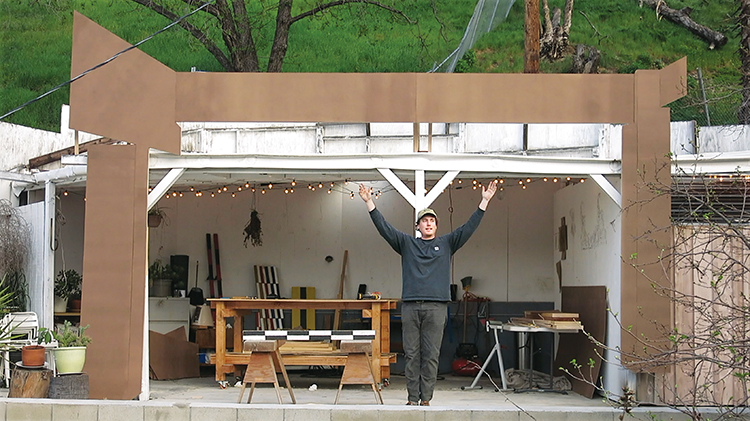In a changing world, John Emison ’09 finds consistency in his artwork.
I am lucky that I was already working from my home studio on the east side of Los Angeles leading up to the pandemic. The studio is a pavilion-like structure set into our sloped backyard, with an open front facing out across our small neighborhood valley.
It feels partly like a theater, where my studio practice is a performance for everybody yet nobody (thank you, Linn Underhill, former associate professor of art and art history), and it’s partly an observatory to track the movement of the setting Sun and rising Venus along the adjacent hill (thank you, Tony Aveni, Russell Colgate Distinguished University Professor of astronomy and anthropology and Native American studies emeritus).
For the past few months, I had been making drawings, maquettes, sculptures, and video work supported by a grant from the Los Angeles gallery Central Park. I had shown at the gallery in 2016 by emptying the space and painting the gallery’s interior cement architectural features. I was interested in how private space could be rendered legible to a public, how the architectural space of the gallery could be activated conceptually and literally, its function becoming ornamentation and back again. Four years later, I revisited the work and was surprised by how my memory of the space differed from the photographs and measurements I had taken, how my memory of the room was slowly being replaced by the documentation photography. Realizing the uncanny similarities between the gallery space and my current studio, I used the 2016 exhibition photographs as a template to construct a stage set and began filming myself in the studio. While I was interested in the ways in which art practices are outwardly performed, I was uncomfortable turning the camera on myself as the subject, as evidenced by my performance in the resulting video John B. Emerson (2020). Little did I realize that self-reflectivity would be so present in the following weeks.
As the self-isolation extended into shelter-in-place, I was fortunate to have access to my backyard studio. Similar to others with the privilege of being relatively protected from the hardest realities of this pandemic, the time spent at home and in the studio has slowed me down to a speed I previously thought of as luxurious and unattainable.
The space made for introspection has led to some strange observations — most surprisingly, the realization of a core in my work that has remained a constant. An elusive but continuous thread reaches from the present to the Central Park exhibition four years ago, my graduate school work six years ago, and my Colgate projects more than a decade ago. If I squint, I can even see some threads loop back to childhood. The spiralic nature of time is becoming more noticeable as I come back to these old interests, some feeling hammered and flat, others sharper and more specific. I’ve even caught myself unwittingly repeating elements of my Colgate senior thesis project. A decade after gutting a scrapyard Toyota sedan (thank you, DeWitt Godfrey, professor of art and art history, and John Knecht, Russell Colgate Distinguished University Professor of art and art history and film and media studies emeritus) and crudely stacking Pennsylvania blue stone inside the car, I suddenly felt the need to learn proper dry stone walling and masonry techniques over the past months.
I find myself returning to basic activities that keep me present, whether it’s chipping away at stone or admiring the austere beauty of humble paper (thank you, Lynn Schwarzer, professor of art and art history and film and media studies). I don’t know how these elements will fit in to my next exhibition or a larger body of work, but they feel right, and that’s enough for now.
— John Emison ’09 is an artist and educator. He and his wife, Alison D’Amato, live in Los Angeles, Calif., with their daughter, Bennett Ruth Emison.

